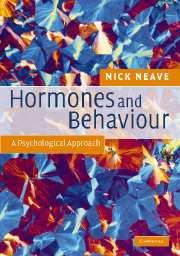Book contents
- Frontmatter
- Contents
- List of diagrams
- Preface
- Acknowledgements
- 1 Background to psychobiology
- 2 Hormones and the endocrine system
- 3 Behavioural endocrinology
- 4 Neurological effects of hormones
- 5 Typical sexual determination/differentiation
- 6 Atypical sexual differentiation
- 7 Neural differentiation
- 8 Reproductive/sexual behaviours
- 9 Attachment/parental behaviours
- 10 Aggressive/competitive behaviours
- 11 Sex steroids and cognition
- References
- Index
6 - Atypical sexual differentiation
Published online by Cambridge University Press: 05 June 2012
- Frontmatter
- Contents
- List of diagrams
- Preface
- Acknowledgements
- 1 Background to psychobiology
- 2 Hormones and the endocrine system
- 3 Behavioural endocrinology
- 4 Neurological effects of hormones
- 5 Typical sexual determination/differentiation
- 6 Atypical sexual differentiation
- 7 Neural differentiation
- 8 Reproductive/sexual behaviours
- 9 Attachment/parental behaviours
- 10 Aggressive/competitive behaviours
- 11 Sex steroids and cognition
- References
- Index
Summary
As I have explained in the previous chapter, at a very basic level normal sexual differentiation seems to be a two-part process. For an embryo to develop into a female then it must become both feminised and demasculinised; normal male development on the other hand depends upon both masculinisation and defeminisation. There are many stages to this complex process and at each stage errors can occur. It is therefore likely that while most individuals will be strongly physically and behaviourally masculinised/defeminised or feminised/demasculinised, some may only partly develop these characteristics, either at a neurological, physical or behavioural level, or at all levels. Research questions concerning the role of the gonadal steroids in sexual differentiation in humans cannot of course be directly tested because of ethical considerations; however, certain developmental quirks have cast considerable light upon sexual differentiation in our species. Specifically, such conditions have enabled researchers to try to ascertain the possible effects of the pre- and perinatal hormonal environment upon subsequent psychosexual differentiation. There are a considerable number of such abnormalities and a thorough discussion of each is beyond the scope of this text. I will instead focus upon the main syndromes that have provided important information not only concerning physical sexual differentiation, but, of key interest to this text, also concerning psychological (gender) differentiation (chapter 11 will discuss cognitive characteristics observed in such syndromes).
- Type
- Chapter
- Information
- Hormones and BehaviourA Psychological Approach, pp. 109 - 134Publisher: Cambridge University PressPrint publication year: 2007

